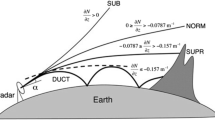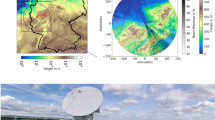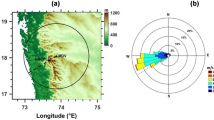Abstract
Weather radars measure changes in the refractive index of air in the atmospheric boundary layer. The technique uses the phase of signals from ground targets located around the radar to provide information on atmospheric refractivity related to meteorological quantities such as temperature, pressure and humidity. The approach has been successfully implemented during several field campaigns using operational S-band radars in Canada, UK, USA and France. In order to better characterize the origins of errors, a recent study has simulated temporal variations of refractivity based on Automatic Weather Station (AWS) measurements. This reveals a stronger variability of the refractivity during the summer and in the afternoon when the refractivity is the most sensitive to humidity, probably because of turbulence close to the ground. This raises the possibility of retrieving information on the turbulent state of the atmosphere from the variability in radar refractivity. An analysis based on a 1-year dataset from the operational C-band radar at Trappes (near Paris, France) and AWS refractivity variability measurements was used to measure those temporal and spatial variabilities. Particularly during summer, a negative bias increasing with range is observed between radar and AWS estimations, and is well explained by a model based on Taylor’s hypotheses. The results demonstrate the possibility of establishing, depending on season, a quantitative and qualitative link between radar and AWS refractivity variability that reflects low-level coherent turbulent structures.







Similar content being viewed by others
Notes
For practical work the equation: \(N=77.6\frac{p}{T}-5.6\frac{e}{T}+3.75\times 10^5 \frac{e}{T^2}\) (Bean and Dutton 1968) can be simplified to the two-term expression, which yields values of N within 0.02 % of those obtained with the three-term expression in the temperature range of \(-50\) to 40\(^{\circ }\hbox {C}\).
References
Bean BR, Dutton EJ (1968) Radio Meteorology no. 92 monograph. National Bureau of Standards, Washington DC
Besson L, Boudjabi C, Caumont O, Parent du Châtelet J (2012) Links between weather phenomena and characteristics of refractivity measured by precipitation radar. Boundary-Layer Meteorol 143:77–95
Besson L, Parent du Chatelet J (2013) Solutions for improving the radar refractivity measurement by taking operational constraints into account. J Atmos Ocean Technol 30:1730–1742
Bodine D, Heinselman PL, Cheong BL, Palmer RD, Michaud D (2010) A case study on the impact of moisture variability on convection initiation using radar refractivity retrievals. J Appl Meteorol Climatol 49:1766–1778
Boudjabi C (2011) Validation de la mesure de réfractivité avec un radar en bande C équipé d’un émetteur à magnétron. Ph-D letter Université Paul Sabatier, Toulouse France
Boudjabi C, Parent du Chatelet J (2009) Evaluation of phase ambiguity problem due to sampling time when measuring refractivity with precipitation radar. In: 34th international conference on radar meteorology, American Meteorological Society, Williamsburg
Caumont O, Foray A, Besson L, Parent du Chatelet J (2013) An observation operator for radar refractivity change: comparison of observations and convective-scale simulations. Boundary-Layer Meteorol 148:379–397
Crook NA (1996) Sensitivity of moist convection forced by boundary layer processes to low-level thermodynamic fields. Mon Weather Rev 124:1767–1785
Dabberdt WF, Schlatter TW (1996) Research opportunities from emerging atmospheric observing and modelling capabilities. Bull Am Meteorol Soc 77:305–323
Ducrocq V, Braud I, Davolio S, Ferretti R, Flamant C, Jansa A, Kalthoff N, Richard E, Taupier-Letage I, Ayral P-A, Belamari S, Berne A, Borga M, Boudevillain B, Bock O, Boichard J-L, Bouin M-N, Bousquet O, Bouvier C, Chiggiato J, Cimini D, Corsmeier U, Coppola L, Cocquerez P, Defer E, Delanoë J, Di Girolamo P, Doerenbecher A, Drobinski P, Dufournet Y, Fourrié N, Gourley JJ, Labatut L, Lambert D, Le Coz J, Marzano FS, Molini G, Montani A, Nord G, Nuret M, Ramage K, Rison B, Roussot O, Saïd F, Schwarzenboeck A, Testor P, van Baelen J, Vincendon B, Aran M, Tamayo J (2014) HyMeX-SOP1, the field campaign dedicated to heavy precipitation and flash flooding in the northwestern Mediterranean. Bull Am Meteorol Soc 95:1083–1100
Emanuel K, Raymond D, Betts A, Bosart L, Bretherton C, Droegemeier K, Farrell B, Fritsch JM, Houze R, Le Mone M, Lilly D, Rotunno R, Shapiro M, Smith R, Thorpe A (1995) Report of the first prospectus development team of the U.S. Weather Research Program to NOAA and the NSF. Bull Am Meteorol Soc 76:1194–1208
Fabry F, Frush C, Zawadzki I, Kilambi A (1997) On the extraction of near-surface index of refraction using radar phase measurements from ground targets. J Atmos Ocean Technol 14:978–987
Fabry F (2004) Meteorological value of ground target measurements by radar. J Atmos Ocean Technol 21:560–573
Gasperoni NA, Xue M, Palmer RD, Gao J, Cheong BL, Michaud DS (2009) Low-level moisture analysis from refractivity data derived from a network of S-band and X-band radars using ARPS 3DVAR. In: 34th conference on radar meteorology, American Meteorological Society, Ed Williamsburg
Gasperoni NA, Xue M, Palmer RD, Gao J (2012) Sensitivity of convective initiation prediction to near-surface moisture when assimilating radar refractivity: Impact tests using OSSEs. J Atmos Ocean Technol 30:2281–2302
Koch SE, Aksakal A, McQueen JT (1997) The influence of mesoscale humidity and evapotranspiration fields on a model forecast of a cold-frontal squall line. Mon Weather Rev 125:384–409
Mahfouf JF, Brasnett B, Gagnon S (2007) A Canadian precipitation analysis (CaPA) project: description and preliminary results. Atmos-Ocean 45(1):1–17
Miao Q, Geerts B, Lemone MA (2006) Vertical velocity and buoyancy characteristics of coherent echo plumes in the convective boundary layer detected by a profiling airborne lidar. J Appl Meteorol Clim 45:838–855
Montmerle T, Caya A, Zawadzki I (2002) Short-term numerical forecasting of a shallow storms complex using bistatic and single-doppler radar data. Weather Forecast 17:1211–1225
Nicol J, Illingworth A, Bartholomew K (2014) The potential of 1h refractivity changes from an operational C-band magnetron-based radar for numerical weather prediction validation and data assimilation. Q J R Meteorol Soc 140(681):1209–1218
Ottersten H (1969) Radar backscattering from the turbulent clear atmosphere. Radio Sci 4:1251–1255
Parent du Chatelet J, Boudjabi C, Besson L, Caumont O (2012) Errors caused by long-term drifts of magnetron frequencies for refractivity measurement with a radar: Theoretical formulation and initial validation. J Atmos Oceanic Technol 29:1428–1434
Roberts RD, Nelson E, Wilson JW, Rehak N, Sun J, Ellis S, Weckwerth T, Fabry F, Kennedy PC, Fritz J, Chandrasekar V, Reising S, Padmanabhan S, Braun J, Crum T, Mooney L, Palmer R (2008) REFRACTT 2006. Bull Am Meteorol Soc 89:1535–1548
Smith EK, Weintraub S (1953) The constants in the equation for atmospheric refractive index at radio frequencies. Proc Inst Radio Eng 41:1035–1037
Stull RB (1988) An Introduction to boundary-layer meteorology. Kluwer Academic, Dordrecht
Sun J (2005) Convective-scale assimilation of radar data: progress and challenges. Q J R Meteorol Soc 131:3439–3463
Taylor GI (1938) The spectrum of turbulence. Proc R Soc 164:476–490
Wakimoto RM, Murphey HV (2009) Analysis of a dryline during IHOP: implications for convection initiation. Mon Weather Rev 137:912–936
Weckwerth TM, Parsons DB, Koch SE, Moore JA, LeMone MA, Demoz BB, Flamant C, Geerts B, Wang J, Feltz WM (2004) An overview of the International H\(_2\)O Project (IHOP_2002) and some preliminary highlights. Bull Am Meteorol Soc 85:253–277
Weckwerth TM, Pettet CR, Fabry F, Park S, Lemone MA, Wilson JW (2005) Radar refractivity retrieval: validation and application to short-term forecasting. J Appl Meteorol 44:285–300
Wesely ML (1976) The combined effect of temperature and humidity fluctuation on refractive index. J Appl Meteorol 15:43–49
Author information
Authors and Affiliations
Corresponding author
Rights and permissions
About this article
Cite this article
Hallali, R., Dalaudier, F. & Parent du Chatelet, J. Comparison Between Radar and Automatic Weather Station Refractivity Variability. Boundary-Layer Meteorol 160, 299–317 (2016). https://doi.org/10.1007/s10546-016-0145-x
Received:
Accepted:
Published:
Issue Date:
DOI: https://doi.org/10.1007/s10546-016-0145-x




